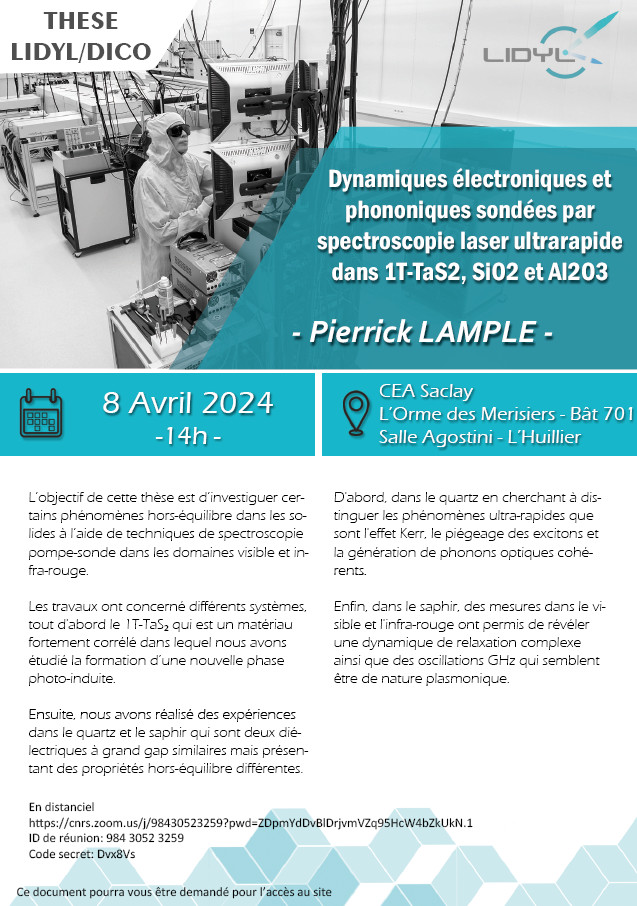Abstract:
The interaction between laser pulses and crystalline materials is a highly rich research topic, both in terms of cutting-edge applications (micro-machining, sensors, imaging, etc.) and fundamental research, as many phenomena are still under investigation (high-order harmonic generation, entangled photons, ultrafast electronics, etc.). Many of these phenomena remain poorly understood, and new properties of materials are frequently discovered. Investigating them is crucial to optimize existing applications, make them more widely accessible, and discover new ones.The objective of this thesis is to investigate some of these out-of-equilibrium phenomena using pump-probe spectroscopy, employing a pulsed laser with a duration of 40 femtoseconds. Two experimental setups were developed to probe the visible and infrared domains, with temperature control and polarization control of the laser beams.We were thus able to study the dynamics of 1T-TaS₂, a strongly correlated material with a rich phase diagram as a function of temperature. In particular, we probed the dynamics of the formation of a new photo-induced phase, which is of great interest to the scientific community due to its complexity. Additionally, we conducted experiments on quartz and sapphire, two wide-bandgap dielectrics that are challenging to excite electronically. Despite their similarities, these two materials exhibit very different out-of-equilibrium behaviors: in quartz, a very fast excitonic trapping dynamic and pronounced nonlinear effects; in sapphire, a much slower relaxation revealing a rich complexity in the infrared. Moreover, the latter material exhibits GHz oscillations that appear to be of plasmonic nature.
Secondly, we study the interaction of angular momentum-bearing XUV beams with magnetic materials. We propose the concept of orbital angular momentum dichroism, or “helical” dichroism, and demonstrate a new form of magnetically induced optical spin-orbit coupling.
Keywords: Condensed matter, Out-Of-Equilibrium physics, Femtosecond laser, Pump-Probe, Phase transition, Dielectrics.
Dynamiques électroniques et phononiques sondées par spectroscopie laser ultrarapide dans 1T-TaS2, SiO2 et Al2O3
Résumé :
L’interaction entre des impulsions laser et un matériau cristallin est un sujet de recherche très riche, que ce soit en termes d’applications de pointe (micro-usinage, capteurs, imagerie…) et de recherche fondamentale car de nombreux phénomènes sont encore à l’étude (génération d’harmoniques d’ordre élevé, photons intriquées, électronique ultra-rapide…). De nombreux phénomènes restent dès lors encore mal compris et très fréquemment de nouvelles propriétés d’un matériau sont découvertes. Leur investigation est cruciale pour parvenir à optimiser les applications utilisées, les démocratiser, mais aussi en trouver de nouvelles.
L’objectif de cette thèse est d’explorer certains de ces phénomènes hors-équilibre à l’aide d’une technique de spectroscopie pompe-sonde qui utilise un laser pulsé à 40 femtosecondes. Deux dispositifs expérimentaux de mesures ont été construits pour sonder dans le domaine visible et infra-rouge tout en ayant un contrôle de température et sur la polarisation de nos faisceaux.Nous avons ainsi été en mesure de sonder la dynamique du 1T-TaS₂ qui est un matériau fortement corrélé présentant un riche diagramme de phases en fonction de la température. Nous avons notamment sondé la dynamique de formation d’une nouvelle phase photo-induite qui intéresse grandement la communauté scientifique du fait de sa complexité. En outre, nous avons réalisé des expériences dans le quartz et le saphir qui sont deux diélectriques à grand gap difficiles à exciter électroniquement. Malgré leurs similarités, ces deux matériaux ont des comportements hors équilibre très différents : dans le quartz une dynamique de capture excitonique très rapide et des effets non-linéaires très marqués, puis dans le saphir une relaxation très lente et révélant une riche complexité dans l’infra-rouge. En outre, ce dernier matériau présente la formation d’oscillations GHz qui semblent être de nature plasmonique.
Mots-clés : Matière condensée, Physique hors-Équilibre, Laser femtoseconde, Pompe-Sonde, Transition de phase, Diélectriques.



